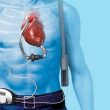The acute chest pain is responsible for more than 11 % of queries to an emergency service . Only 10% of these patients really have an acute myocardial infarction. The standard protocol for managing these patients includes serial electrocardiogram, dosage of biomarkers and an observation time of 6-12 hours. This overloads the emergency services and<a href="https://solaci.org/en/2015/06/24/bic-8-copetin-associated-with-troponin-can-rule-out-acute-myocardial-infarction-in-the-emergency-room/" title="Read more" >...</a>
Best ejection fraction using Metoprolol as pretreatment in acute myocardial infarction
Original title: Long-Term Benefict of Early Pre-Reperfusion Metoprolol Administraction in Patients With Acute Myocardial Infaction. From the METOCARD-CNIC Trial. Reference: Gonzalo Pizarro et, al. J Am Coll Cardiol 20141;63:2356-62 The anterior infarction with ST- segment elevation has a high morbidity and mortality, both in the acute phase as well as after the presence of heart failure, arrhythmias<a href="https://solaci.org/en/2014/06/25/best-ejection-fraction-using-metoprolol-as-pretreatment-in-acute-myocardial-infarction/" title="Read more" >...</a>
Multivessel angioplasty in acute myocardial infarction improves prognosis
Original title: Acute multivessel revascularization improves 1 year outcomes in ST-elevation myocardial infarction. A nationwide study from AMIS plus registry. Reference: Raban Jeger, et al. International journal of Cardiology 2014;172:76-81 The presence of multiple vessel lesions is present in about 50% of patients referred for primary angioplasty. The accepted strategy is to treat the culprit artery even<a href="https://solaci.org/en/2014/03/07/multivessel-angioplasty-in-acute-myocardial-infarction-improves-prognosis/" title="Read more" >...</a>
Prognostic Impact of SYNTAX and SYNTAX II Scores in Patients with Acute Myocardial Infarction
Acute myocardial infarction (AMI) continues to be a clinically significant condition due to its association with morbidity and mortality after the initial event. Therefore, the prognostic stratification of these patients is of vital importance. One of the tools that have been used for several years for this purpose is the SYNTAX I (SS) and SYNTAX<a href="https://solaci.org/en/2023/09/25/prognostic-impact-of-syntax-and-syntax-ii-scores-in-patients-with-acute-myocardial-infarction/" title="Read more" >...</a>
Mitral Valve Edge to Edge Repair for Papillary Muscle Rupture after Acute Myocardial Infarction
With an approximate incidence of 0.05% to 0.25%, post-acute myocardial infarction (AMI) mitral valve failure caused by papillary muscle rupture is not exactly common. However, it is associated to high mortality rate, ranging between 36% and 80%. Current guidelines recommend surgical treatment, but more often than not surgery involves prohibitive or extremely high risk, with<a href="https://solaci.org/en/2023/07/14/mitral-valve-edge-to-edge-repair-for-papillary-muscle-rupture-after-acute-myocardial-infarction/" title="Read more" >...</a>
Association Between Radial Wall Strain (RWS) and Risk of Acute Myocardial Infarction
Despite major advances in secondary prevention and reperfusion strategies, acute myocardial infarction (AMI) still causes morbidity and mortality. A significant portion of acute events arise from mild to moderate lesions identified months to years before the index event. Early detection of lesions at higher risk of progression and rupture may allow for more targeted treatment<a href="https://solaci.org/en/2023/06/09/association-between-radial-wall-strain-rws-and-risk-of-acute-myocardial-infarction/" title="Read more" >...</a>
Re-Watch Coronary Bifurcation Angioplasty in Acute Myocardial Infarction
You can now relive our virtual event on Coronary Bifurcation Angioplasty in Acute Myocardial Infarction. Coronary Bifurcation Angioplasty in Acute Myocardial Infarction
Ventricular Assist Device in Acute Myocardial Infarction
Original Title: Ventricular Assist Device in Acute Myocardial Infarction. Reference: Deepak Acharya et al. J Am Coll Cardiol. 2016;67(16):1871-1880. Patients undergoing acute myocardial infarction (AMI) with acute cardiac failure or cardiogenic shock have a high mortality rate with the conventional treatment. This study assessed the outcomes of patients with AMI receiving a durable ventricular assist<a href="https://solaci.org/en/2016/04/21/ventricular-assist-device-in-acute-myocardial-infarction/" title="Read more" >...</a>
BVS-STEMI-FIRST OCT study: Bioabsorbable platform in acute myocardial infarction
A bioabsorbable platform implant in the context of ST segment elevation acute myocardial infarction is feasible although the subsequent cicatrization of the artery is not documented. The objective of this work was to evaluate optical coherence tomography (OCT) in patients who received everolimus-releasing bioabsorbable platform in the context of primary angioplasty. A total of 39<a href="https://solaci.org/en/2015/06/24/bvs-stemi-first-oct-study-bioabsorbable-platform-in-acute-myocardial-infarction/" title="Read more" >...</a>
SMART: Manual Thrombectomy vs. Rheolytic Aspiration in ST-segment Elevation Acute Myocardial Infarction.
Dr. David Antoniucci presented the immediate results of randomized trial SMART SMART (n=80, 1:1) comparing manual thrombectomy (MAT) vs. rheolytic aspiration (RT) in the context of ST elevation acute myocardial infarction (≤6 hours). In this study, primary outcome was residual thrombus burden after aspiration assessed with optical coherence tomography (OCT). Thrombus burden was defined as<a href="https://solaci.org/en/2015/06/24/smart-manual-thrombectomy-vs-rheolytic-aspiration-in-st-segment-elevation-acute-myocardial-infarction/" title="Read more" >...</a>








